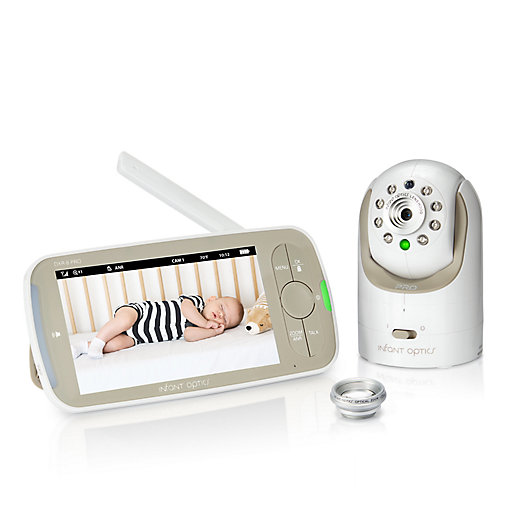Infant Optics DXR-8 PRO 5-Inch Baby Monitor in White/Beige
5” screen with 720P HD Video- Active Noise Reduction Technology. Video playback is displayed in 720P high definition (HD) resolution. See details clearly even when the camera unit is placed far away from the crib. Features a set of 1000mW speakers engineered just for the DXR-8 PRO.
Keep a close eye on your little one as they sleep with the Infant Optics DXR-8 PRO Video Baby Monitor. With no confusing setup, just simply plug in to get peace of mind, this unique baby monitor features interchangeable lenses for the perfect view.
- 5” screen with 720P HD Video- Active Noise Reduction Technology
- Video playback is displayed in 720P high definition (HD) resolution
- See details clearly even when the camera unit is placed far away from the crib
- Features a set of 1000mW speakers engineered just for the DXR-8 PRO
- Results in louder volume and crisper audio quality
- Switch between the zoom lens and wide-angle lens (sold separately) to see closer or further
- Lens Included
- 2-way talkback
- Talkback to your baby to sooth him/her back to sleep
- Sound Activated LED Bar
- 2800mAh battery included
- Plastic construction
- Measures .8″ L x 6.6″ W x 3.2″ H
- Weighs 1.61 lb.
- 1-year limited manufacturer’s warranty
- Imported
- Model DXR-8 PRO
- Infant Optics Add-On Camera Unit not compatible with the Infant Optics DXR-8 PRO LCD Video Baby Monitor
- skuId: 69627461
Additional information
| Product Depth in | 0.8 |
|---|---|
| Product Width in | 6.6 |
| Product Weight lb kg | 1.61 |
| Parent Unit Screen Size in | 5 |
| Part or Model Number | DXR-8 PRO |
| Product Type | Baby Monitor |






by Mary
My husband and I originally had a fancier camera, but returned it due to the fact that we wanted something that did not connect to our wifi and we did not need an app that connected to our smartphones. This camera is perfect for what we were looking for. The camera screen is really clear during both the day and night, and the sound quality is excellent. I really like the fact that the camera can cancel out the background noise on the screen as we often have white noise or something else playing in the background while our little one sleeps. I also really like that the volume button lights up even if you have the monitor on sleep mode. I do have to charge this frequently, but that is due to the fact that I keep the video monitor on majority of the time while using it. Overall, this is an excellent camera, and I will be recommending it to anyone who is expecting.
by Allison
We just had our third, and our prior monitors are given away or dead. This one is better than anything we had before (2 were via our phones, 1 was VTech). Easy to operate, great quality image, zoom/scan, and the parent unit is responsive (turns on/off easily, boots up quickly, etc). Great product!
by Pinel
The camera was easy to set up. The clarity on the camera is amazing. You are able to adjust the volume and brightness to your liking. The one thing I wish it had was the option to download an app and watch from your phone as well. I love having the monitor for the babysitter but I would also like to see my son from my phone. Overall, love this monitor.
by Beth
The camera works extremely well and will give you peace of mind! It’s easy to setup and the camera/monitor provide a great view of your baby around the clock. I love the dedicated volume buttons – it makes it much easier to quickly turn of the volume when needed.
by Amanda
We LOVE our baby monitor. The sound quality and picture quality is great. I love that I can talk to my kids through the monitor, see the majority of the room, and that it scans between the two rooms that we have cameras. Great product with wonderful and helpful customer care representatives. 5/5 I definitely recommend this monitor.
by Barry
We love this monitor! I love the clear image, you can cancel out any background noise (like a sound machine), you can adjust the brightness of the screen, it’s easy to set up, and you can also zoom in on your baby.